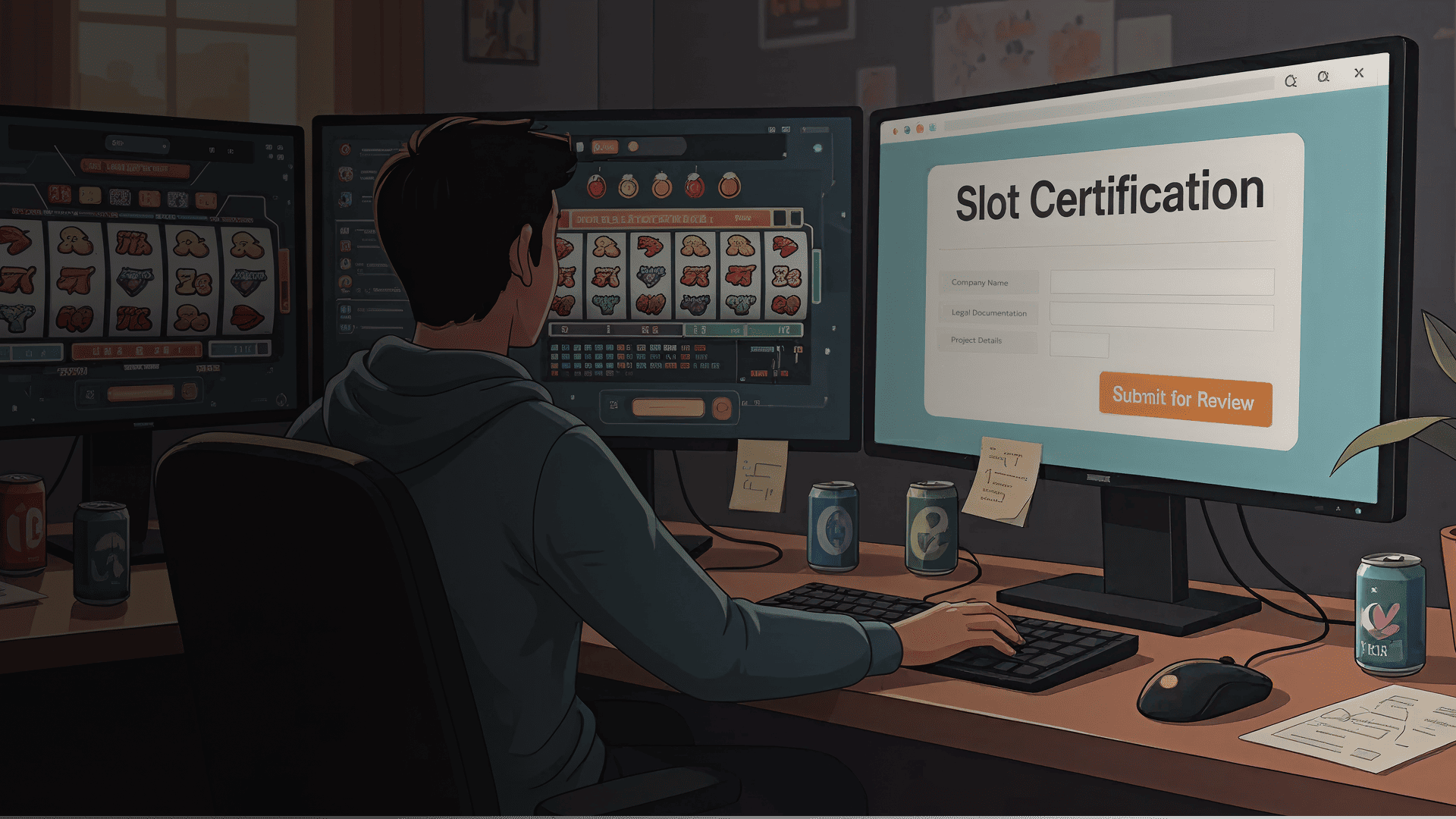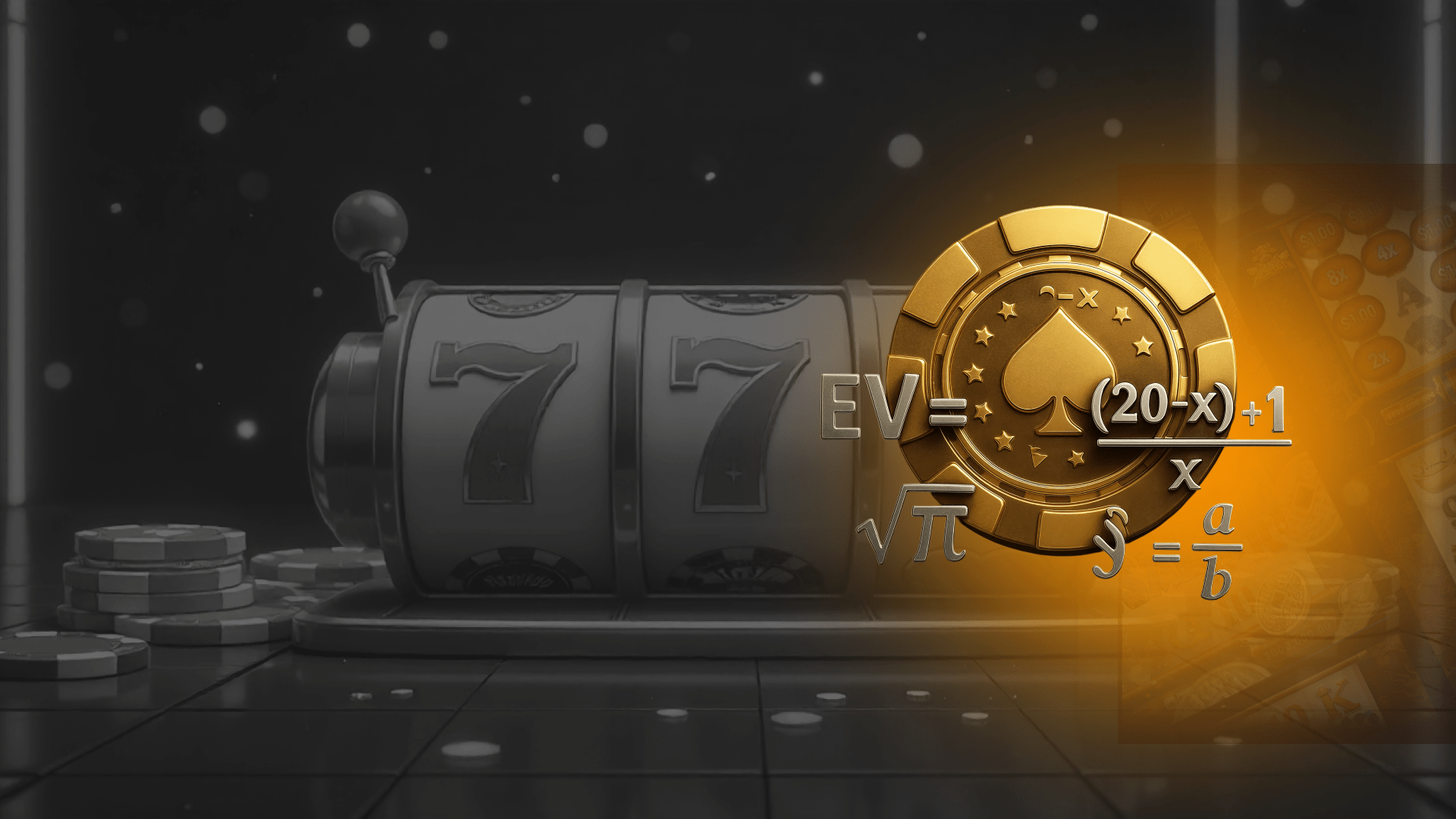Some slots pay small wins constantly. Others go silent for 100 spins before dropping a 500x hit. Both games might have 96% RTP, yet they feel completely different to play.
The difference is slot volatility. Understanding what volatility means in slots is essential for operators choosing games, studios designing them, and platforms building portfolios that retain players.
This guide explains slot variance, how developers engineer it, and why getting volatility right determines whether your games drive revenue or kill retention.
What Is Slot Volatility?
Slot volatility (also called variance) measures the risk level and payout behavior of a slot game. It tells you two critical things:
- How often you’ll win (hit frequency)
- How much you’ll typically win (payout size)
Think of it as the game’s personality. Low volatility slots are friendly and predictable, lots of small wins keep you entertained. High volatility slots are wild and unpredictable, long dry spells punctuated by potentially life-changing payouts.
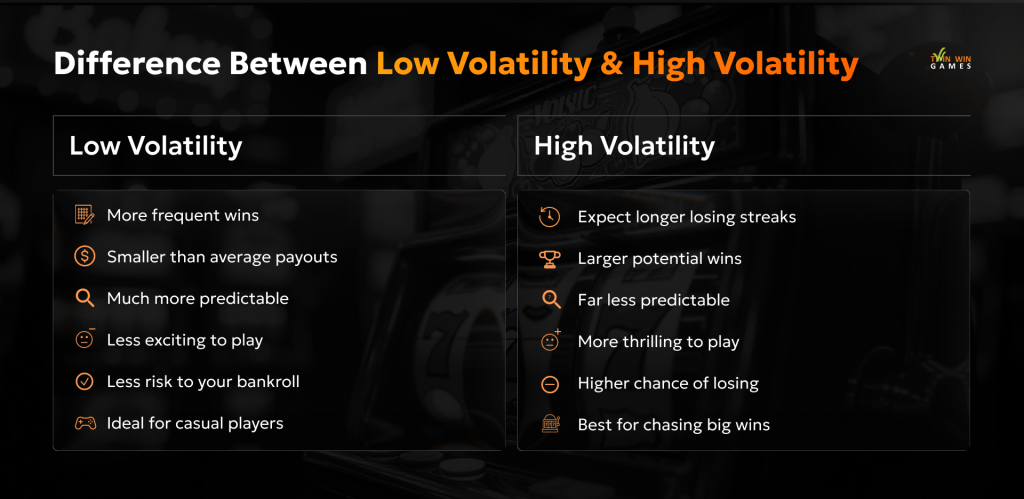
How Developers Calculate Volatility
Behind every slot is a complex mathematical model. Slot developers like Twin Win Games use sophisticated probability calculations to design the volatility profile:
- Symbol distribution across reels determines hit frequency
- Paytable structure defines the ratio between small and large wins
- Bonus feature mechanics add layers of variance
- Maximum win potential sets the upper risk ceiling
A slot with many medium-paying symbols and frequent bonus triggers? That’s low volatility by design.
A game with rare scatter symbols that unlock massive multipliers? High volatility all the way.
The volatility engineered into every spin based on weighted reel positions and probability distributions..
Why Slot Volatility Determines Performance
Wrong volatility alignment with your player base wastes acquisition spend and kills retention.
Player Acquisition Cost Impact
You spend $200-400 acquiring a player. If they deposit $50 into a high volatility slot, lose it in 12 minutes with zero wins, and never return, that acquisition cost is gone. The same player in a low volatility game plays 45 minutes, enjoys frequent small wins, and returns three days later.
Retention Metrics by Volatility
Based on analysis across 50+ operators:
1. Low volatility games: 35-45% Day 7 retention among casual players
2. Medium volatility games: 28-35% Day 7 retention across all segments
3. High volatility games: 18-25% Day 7 retention (self-selected thrill-seekers)
Session Length Patterns
Low volatility extends sessions through frequent reinforcement. Players stay engaged longer per dollar spent. High volatility creates shorter sessions for most players, but extremely long sessions when bonus rounds hit.
ARPDAU Optimization
Medium volatility produces optimal average revenue per daily active user. Low volatility maximizes player count but lower individual spend. High volatility produces highest ARPDAU among active players but smaller player pools.
The Five Volatility Levels Explained
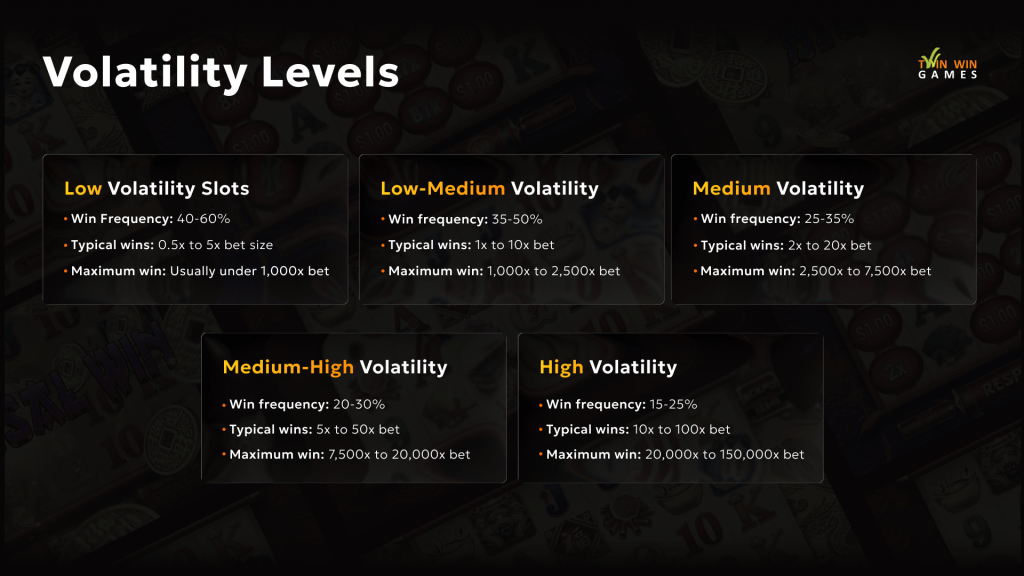
Low Volatility Slots
- Win frequency: 40-60% of spins result in payouts
- Typical wins: 0.5x to 5x bet size
- Maximum win: Usually under 1,000x bet
Low volatility slots deliver steady small wins. Your balance moves up and down gently. These games work for wagering requirements, casual player retention, and markets with low average deposits.
Operator benefits include predictable GGR forecasting, fewer player complaints about fairness, and strong performance in promotional campaigns where players need to feel wins.
Example: Starburst (NetEnt).
Low-Medium Volatility
- Win frequency: 35-50% of spins
- Typical wins: 1x to 10x bet
- Maximum win: 1,000x to 2,500x bet
These games balance retention with occasional excitement. Players win often enough to stay engaged but encounter meaningful wins that encourage sharing and continued play.
Example: Twin Spin (NetEnt).
Medium Volatility Slots
- Win frequency: 25-35% of spins
- Typical wins: 2x to 20x bet
- Maximum win: 2,500x to 7,500x bet
Medium variance slots deliver optimal business results for most operators. They maintain reasonable retention while preserving profit margins. These games appeal to both casual and serious players.
This volatility level produces the highest overall profitability per game because it balances player satisfaction with operator revenue needs. Medium volatility works for flagship lobby positions and broad marketing campaigns.
Example: Book of Dead (Play’n GO).
Medium-High Volatility
- Win frequency: 20-30% of spins
- Typical wins: 5x to 50x bet
- Maximum win: 7,500x to 20,000x bet
These games self-select for experienced players who understand variance. They create memorable big wins that drive social sharing and word-of-mouth marketing.
Operators benefit from higher ARPDAU among engaged segments and strong tournament performance. However, GGR becomes less predictable month-to-month.
Example: Dead or Alive 2 (NetEnt).
High Volatility Slots
- Win frequency: 15-25% of spins
- Typical wins: 10x to 100x bet (when they hit)
- Maximum win: 20,000x to 150,000x bet
High volatility slots accept brutal losing streaks in exchange for potentially massive payouts. Most players lose deposits quickly. When bonus rounds trigger, payouts are substantial.
These games function as marketing vehicles more than profit centers. The massive maximum wins attract streamers, create viral content, and position brands as destinations for big wins.
Risk management is essential. Set lower RTPs (95-96%), apply betting limits, exclude from certain bonuses, and monitor for responsible gaming triggers.
Example: Money Train 2 (Relax Gaming).
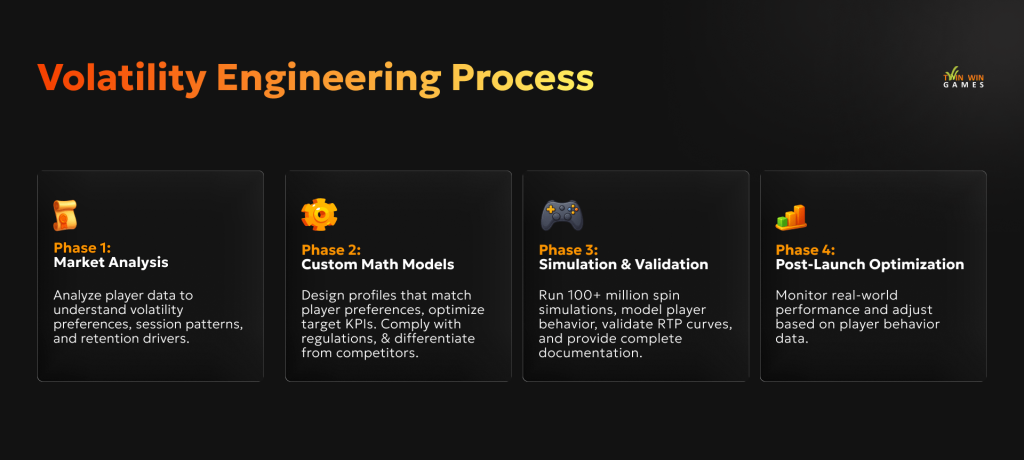
Designing volatility levels effectively requires a structured process that connects: player data, math modeling, and validation. At Twin Win Games, we apply a proven four-phase Volatility Engineering Process to ensure every slot performs as intended. Both for players and operators.
Get expert input on your slot math. Contact us.
RTP and Volatility in Slot Design
RTP (Return to Player) and volatility measure different things. Confusing them leads to poor game selection.
RTP Definition
RTP is the statistical average returned to players over millions of spins. A 96% RTP means the game returns $96 for every $100 wagered across its lifetime. This happens over the long term, not individual sessions.
Volatility Definition
Volatility describes how those returns distribute across time. It measures the rhythm and pattern of wins, not the total amount returned.
Same RTP, Different Experience
Two games both offer 96% RTP:
1. Game A (Low Volatility): Player deposits $100, plays 45 minutes, loses $6, enjoys frequent small wins, returns next week. Feels fair and entertaining.
2. Game B (High Volatility): Player deposits $100, loses it in 18 minutes with minimal wins, leaves frustrated. Or hits a bonus and wins $200, leaves ecstatic. Same RTP, wildly different outcomes.
Business Implications
For casual mobile audiences, prioritize lower volatility even if RTP is slightly lower. A 94% RTP low volatility game retains players better than a 97% RTP high volatility game.
For VIP segments, offer higher volatility with competitive RTP (96%+). These players understand variance and expect big win potential.
If you want a deeper look at how RTP is modeled and how game math affects performance, read our guide on casino math fundamentals.
Building Strategic Slot Portfolios
Smart operators build balanced portfolios, not random game collections.
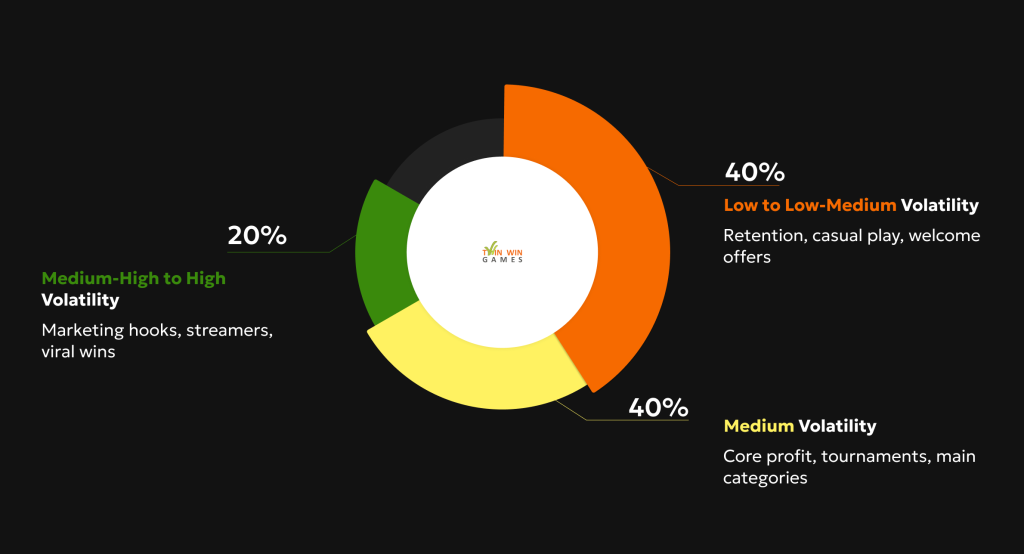
The 40-40-20 Framework
Based on successful European operators:
40% Low to Low-Medium Volatility: Volume drivers for retention, wagering requirements, and casual satisfaction. Place in top lobby positions and welcome offers.
40% Medium Volatility: Core profit centers with broad appeal. Feature in main categories, tournaments, and cross-promotions.
20% Medium-High to High Volatility: Marketing hooks that attract streamers and create viral moments. Use for new releases and max-win showcases.
Market-Specific Adjustments
- UK market: Emphasize medium-low volatility due to regulatory scrutiny of high variance games. Transparent labeling is increasingly expected.
- Asian markets: Strong preference for medium-high volatility. Cultural affinity for big wins. Accept lower RTPs if maximum wins are attractive.
- Latin America: Mobile-first audiences favor medium volatility. Price-sensitive players respond to volume over margin.
- Northern Europe: Sophisticated players understand variance. Higher preference for high volatility combined with competitive RTP.

Volatility and Responsible Gaming
High volatility games require specific player protections.
Regulatory Requirements and Recent Changes
1. UK Gambling Commission introduced statutory maximum stake limits on online slots in 2025: £5 per spin for adults 25 and over, and £2 per spin for young adults aged 18 to 24 UK Parliament. This represents a major regulatory shift targeting high-risk products.
2. Online slots are associated with long sessions, with over 70% of gaming sessions lasting over 3 hours being on slots GOV.UK. Slots had the highest proportion of players (5.5%) who ever played for longer than three hours.
3. Financial vulnerability checks now required at £500 monthly deposits (starting August 2024), reducing to £150 monthly from February 2025 Gambling CommissionThe UK Rules. This represents a significant tightening of oversight.
4. Game design regulations implemented in 2025 mandate minimum 5-second spin times, ban autoplay and turbo modes, and prohibit celebratory effects for wins equal to or less than the original stake The UK RulesWiltshire 999s.
Other jurisdictions follow similar patterns. Sweden, Netherlands, and Germany increased focus on high variance games with enhanced player protection requirements.
Implementation Strategies
- Loss velocity monitoring: Alert when players lose 50% of balance in under 10 minutes. Require breaks after 75% loss in under 20 minutes.
- Informed consent: Before playing high volatility games, show clear classification, expected session duration for typical budgets, and comparison to lower variance alternatives.
- Differential limits: Apply stricter controls to high variance games including lower maximum bets, shorter session limits, and bonus restrictions.
When Custom Volatility Makes Sense
Off-the-shelf games serve general purposes. Custom development delivers competitive advantages.
1. You Have Unique Player Data
When analytics show unusual volatility preferences compared to market averages, custom math models improve performance significantly. One European mobile operator increased Day 7 retention from 27% to 41% with custom low-medium volatility games designed specifically for their casual audience.
2. You Need Regulatory Compliance
Some jurisdictions impose unique constraints on maximum wins, RTP floors, or hit frequencies that standard games don’t accommodate. Custom development ensures compliance while maintaining player appeal.
3. You Want Proprietary Differentiation
Exclusive games optimized for your player base cannot be offered by competitors. This improves player stickiness and reduces churn to platforms offering identical game libraries.
Key Takeaways for Operators and Studios
1. Match volatility to player segments. Wrong variance wastes acquisition spend and kills retention.
2. Build balanced portfolios using strategic frameworks like 40-40-20. Every game should serve specific business purposes based on volatility profile.
3. Understand RTP versus volatility. Same RTP with different variance produces completely different business outcomes.
4. Request complete math documentation. Never add games without understanding the underlying models.
5. Test before launch. Simulate player behavior and validate claims before committing resources.
6. Implement responsible gaming protections for high variance titles. Regulatory scrutiny continues increasing globally.
7. Consider custom development when you have specific player demographics, regulatory requirements, or competitive positioning needs.
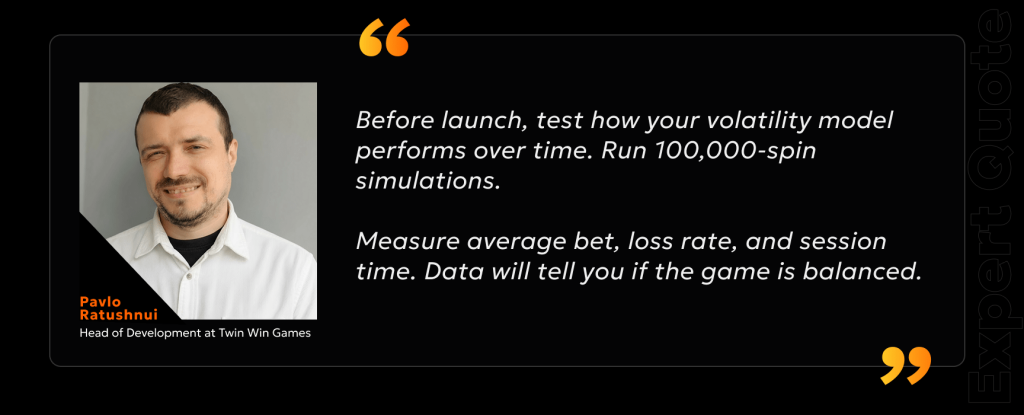
Volatility is a strategic lever that directly impacts player acquisition costs, retention rates, lifetime value, and regulatory compliance.
Ready to optimize your slots portfolio with strategic volatility engineering? Contact us now or drop a line to info@twinwingames.com.


